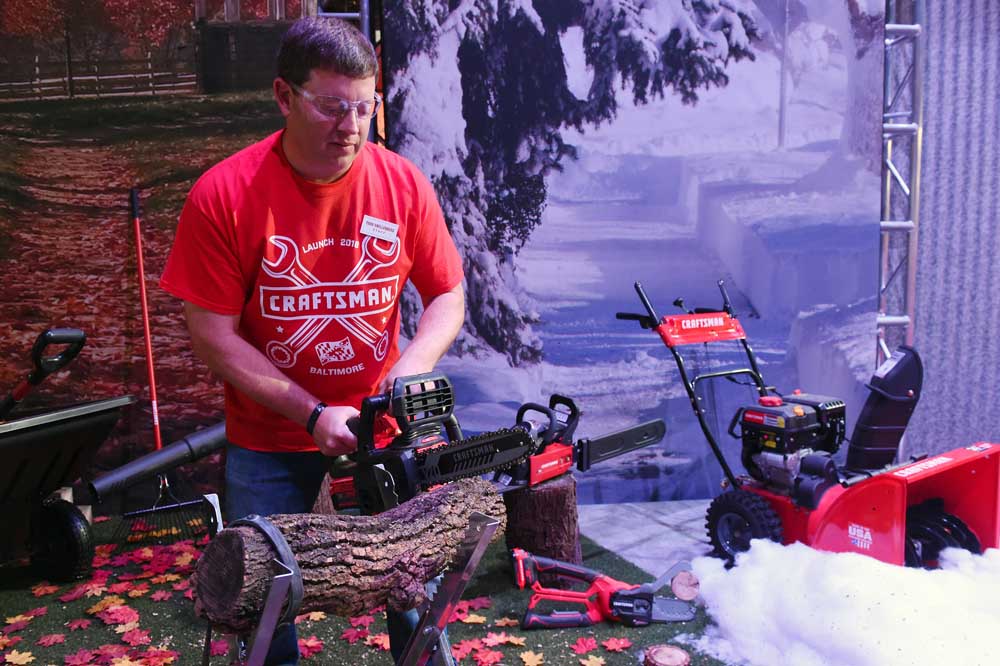Craftsman tool relaunch takes the brand beyond Sears
Published 12:00 am Saturday, August 18, 2018

- Todd Snellenburg, vice president of global licensing, shows off the Craftsman chainsaws on Thursday. Stanley Black & Decker bought Sears’ Craftsman tool line last year.(Kim Hairston/Baltimore Sun/TNS)
Soon after Stanley Black & Decker bought the well-known Craftsman brand from Sears Holdings last year, it embarked on what it says is a ground-up remake of the tool line, hoping to revitalize a name that had languished alongside the struggling department store.
Stanley spent the past 18 months designing and making a new line of Craftsman products, the first 1,200 of which were unveiled Thursday during an event in the “Craftsmen Garage” in Middle River, Maryland.
Trending
The “garage” is being used to “bring Craftsman to life, here in Baltimore,” said Jeff Doehne, the general manager of the Craftsman brand, which will be managed out of the Towson, Maryland, headquarters of Stanley’s power tools and storage divisions.
The company says its designers aimed to keep the tools durable and affordable while making them more efficient and compatible with new technology. A new line of battery packs are versatile enough to start a gas-powered lawnmower or snap on to a cordless impact driver.
Rows of bright red power tools, storage chests and outdoor equipment were on display in the space the company has used for about a year to give hands-on demonstrations to retail customers, investors, employees and others.
The first wave of the new line will launch this fall at Lowe’s and Ace hardware stores and be sold on Amazon in time for the holiday retail season. A limited number of products, more than 30, have been on the shelves since May at Lowe’s stores nationwide. Craftsman sales have totaled about $30 million in its first three months.
“We … have seen great interest in the brand,” said Jenny Popis, a Lowe’s spokeswoman, in an email. Craftsman “is known in the minds of consumers for being trusted to deliver high-quality products at a value, backed by a great warranty.”
Stanley appears to be targeting the market between high-end professional tools and lower-priced products for more casual users, one marketing expert said.
Trending
“They now have a sharp designed line that brings some Dewalt toughness, industrial design and a uniquely American red brand to the market,” said Ed Callahan, co-founder and creative strategist of Baltimore-based Planit advertising and marketing firm. “With this, it appears they are taking a new approach to the exploding DIY market and introducing a midlevel line for the pro-seeking consumer that wants to have a tool that feels and looks pro without the price.”
Craftsman had lost some of its appeal at Sears, but “the brand was too big to be too badly damaged,” Callahan said.
Sears launched the brand in 1927, offering an unlimited lifetime warranty on the hand tools, saying it would replace damaged or broken tools free of charge. The warranty helped cement the tool line’s reputation for quality that remains to this day.
Connecticut-based Stanley, which is paying nearly $900 million over three years for the brand in a deal that closed in March 2017, is exploring additional retail channels toward a goal of eventually growing Craftsman into a $1 billion business.
Stanley and Sears announced the Craftsman sale in January 2017. While analysts expected the deal to boost Black & Decker, offering it opportunities with a well-known brand, they thought the loss of exclusivity could harm Sears, which has been closing stores, by giving consumer another reason to skip its stores. About 90 percent of Craftsman products had been sold almost exclusively through Sears, Kmart and Sears Hometown stores.








